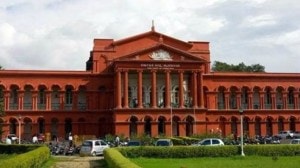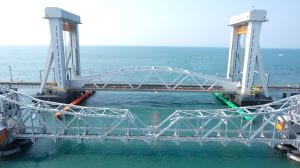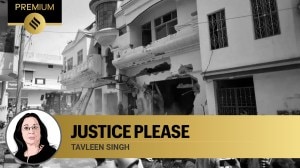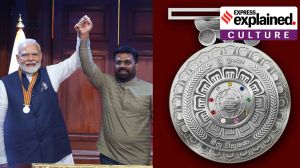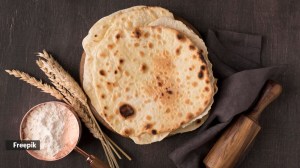UPSC Key: Trump’s Reciprocal Tariffs, Arctic Region and Smoot-Hawley Tariff Act
Why declaration of assets by judges is relevant to the UPSC exam? What is the significance of topics such as Great Depression, Heard and McDonald Islands and deglobalization on both the preliminary and main exams? You can learn more by reading the Indian Express UPSC Key for April 4, 2025.
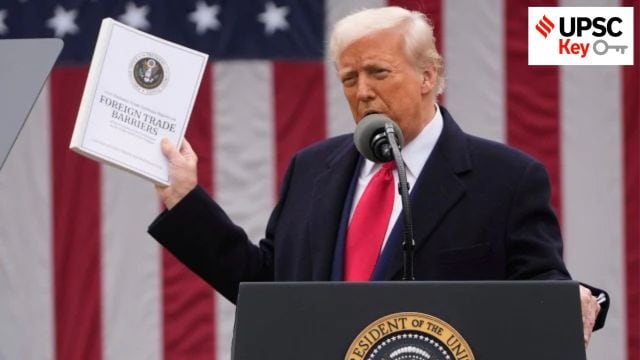 UPSC Key April 2025: Here's what you should be reading from the April 4, 2025 edition of The Indian Express
UPSC Key April 2025: Here's what you should be reading from the April 4, 2025 edition of The Indian Express Important topics and their relevance in UPSC CSE exam for April 4, 2025. If you missed the April 3, 2025 UPSC CSE exam key from the Indian Express, read it here
FRONT PAGE
India exports hit with 27% tariff, Asian peers face higher duties
Syllabus:
Preliminary Examination: Current events of national and international importance
Main Examination: General Studies II: Effect of policies and politics of developed and developing countries on India’s interest
What’s the ongoing story: US President Donald Trump launched the most aggressive global tariff war yet, even by his own standards set in the first term, dealing a blow to the post-World War II liberal trade order that America helped build.
Key Points to Ponder:
• US tariffs on India—know the key highlights
• What you understand by ‘trade protectionism’?
• Do you think that rather than hurting the domestic economy, tariffs will protect more of it?
• What does the term deglobalization mean?
• What is “Friendshoring,” often mentioned in global trade discussions?
• Know the consequences of protectionist trade policies on global supply chains.
• Where does the World Trade Organization (WTO) fit in this aggressive global tariff war?
• How rising trade protectionism and economic nationalism will impact India’s global trade? policies
Key Takeaways:
• Trump set the reciprocal tariff for India at 27 per cent, lower than many Asian rivals, but one that would impact exporting sectors such as gems and jewellery, and auto components.
• The announcements roiled markets Thursday morning with the Dow industrials dropping 1,450 points, or 3.4 per cent, and the Nasdaq plunging 5.8 per cent. The turmoil didn’t stop with the stock markets; oil slid more than 6 per cent and the dollar fell to its lowest level of the year dropping 2 per cent against the euro and Japanese yen.
• On Wednesday, Trump claimed his tariffs will “reverse the economic damage left by the previous administration” and put America on a path to a “new golden age”. As a first step in resetting the trade order, he imposed a blanket 10 per cent tariff on all countries.
• He followed this up with individual reciprocal tariff rates on nations with which the US has a high trade deficit, pulling global stock indices down and increasing the odds of a US recession that could eventually slow global trade growth.
• Trump slapped tariffs of 10-20 per cent on Western partners such as the UK and the European Union, but his focus remained firmly on China and countries receiving significant Chinese investment—touted as China-plus-one nations—acting as conduits for Chinese products into the Western world.
• While US tariffs on India were set at 27 per cent despite ongoing trade negotiations, China was hit with 34 per cent tariffs, pushing the effective US tariff rate on Chinese goods to a record 54 per cent after factoring in earlier tariffs.
• In what could potentially benefit India, most of its Asian peers, which are home to the global manufacturing supply chain, are set to face higher tariff rates, including 36 per cent on Thailand, 32 per cent on Indonesia, and 48 per cent on Laos.
Do You Know:
• Tariffs on India came even as the Indian industry had expected relief due to ongoing India-US trade negotiations, where India had indicated substantial tariff cuts.
• Former trade officer and head of the think tank GTRI, Ajay Srivastava, stated the imposition of higher reciprocal tariffs by the United States on several Asian countries—including China, Vietnam, Taiwan, Thailand, and Bangladesh—presents an opportunity for India to strengthen its position in global trade and manufacturing.
• A White House fact sheet stated that the US will impose a 10 per cent tariff on all countries from April 5, and an individualised reciprocal higher tariff on countries with which the United States has the largest trade deficits from April 9.
• Referring to the US Trade Representative (USTR) report on foreign trade barriers, Trump claimed that for decades, the US had reduced
trade barriers for other countries, while those nations imposed massive restrictions on American products.
• The USTR report on trade barriers criticised India’s high applied tariffs on a wide range of goods, including vegetable oils, apples, maize, motorcycles, automobiles, flowers, natural rubber, coffee, raisins, walnuts, and alcoholic beverages. It noted that the gap between India’s WTO-bound and applied tariff rates allows the government to adjust tariffs unpredictably, creating uncertainty for US stakeholders.
• “The Indian government has leveraged this flexibility, increasing tariffs on approximately 70 product categories in the 2019/2020 budget and on 31 categories in 2020/2021, including key US exports,” the report said.
Other Important Articles Covering the same topic:
📍Trump shreds old globalisation map, what India needs for the road ahead
📍Pharma gains on exemption, but gems, jewellery and auto may take a hit
📍In dark cloud, a few silver linings for India: Tariff level, trade talks, reforms
📍What’s the maths behind Trump’s tariff rates?
📍Tariff-induced global slowdown may hit India growth
THE SECOND PAGE
Arctic melting: India’s polar research agency chief warns of impact
Syllabus:
Preliminary Examination: General issues on Environmental ecology, Bio-diversity and Climate Change – that do not require subject specialization.
Main Examination: General Studies III: Conservation, environmental pollution and degradation, environmental impact assessment.
What’s the ongoing story: When the Arctic Ocean becomes ice-free in summer in the coming decades, the region will become a “hotbed” of international geopolitics, said Dr Thamban Meloth, director of the Goa-based National Centre for Polar and Ocean Research (NCPOR) Goa, the nodal agency for India’s polar expeditions.
Key Points to Ponder:
• What is happening in the Arctic?
• Map Work– Arctic and Antarctica
• What is National Centre for Polar and Ocean Research?
• ‘Antarctica and the Arctic are important in controlling the global weather patterns’—Discuss
• Examine India’s role in Arctic.
• What is the Arctic Council?
• What do the Arctic Council do?
• What are the countries in the Arctic Council?
• Map Work-Eight countries in the Arctic Council
• What is the Antarctic Treaty System?
Key Takeaways:
• At an event to commemorate the 25th Foundation Day of NCPOR on Thursday, Meloth said Antarctica and the Arctic are important in controlling the global weather patterns
• “Recent studies have shown that melting of Arctic sea-ice can impact the Indian monsoon precipitation and its extremes. Antarctica houses nearly 70% global freshwater in frozen form… If it melts, it can lead to an increase in sea level by about 60 metres, potentially sinking all the coastal cities. Although melting of ice happens in the polar regions, the actual rise in sea level is much higher in tropical regions like ours, due to various compounding factors. So, what happens in Antarctica or the Arctic does not stay there. It seriously affects us,” he said.
• Meloth said that as “the Arctic sea-ice will disappear during the summer in the coming decades, the region will become a hotbed of international geopolitics due to the availability of mineral and fishery resources hidden below the frozen sea as well as by potentially opening a northern sea route”.
• At the event, officials reminisced about India’s first scientific expedition to Antarctica and the circumstances around setting up India’s first research station – Dakshin Gangotri – in Antarctica in 1983.
Do You Know:
• On December 6, 1981 a 21-member crew of scientists, technicians and Navy personnel aboard a chartered Norwegian ship MV Polar Circle set sail from Goa’s Mormugao harbour. Part of India’s first scientific expedition to the ‘White Continent’, the crew set foot on the coast of Queen Maud Land a little over a month later, on January 9, 1982, and hoisted the Indian flag.
• Sea ice refers to the free-floating ice in the polar regions. While it generally expands during the winter and melts in the summers, some sea ice remains year-round. Note that this is different from icebergs, glaciers, ice sheets, and ice shelves, which form on land.
• Sea ice plays a crucial role in cooling the planet by trapping existing heat in the ocean, and thus precluding it from warming the air above. Therefore, a reduction in sea ice cover can have disastrous consequences for Earth.
• Currently, Arctic sea ice is at its lowest recorded extent for the time of year. Meanwhile, Antarctic sea ice is close to a new low, based on satellite records going back to the late 1970s. But given historical trends, this is not all that surprising. Since the late 1970s, NSIDC has estimated that some 77,800 sq km of sea ice has been lost per year.
Between 1981 and 2010, Arctic sea ice extent in September — when it reaches its minimum extent — shrunk at a rate of 12.2% per decade, according to the National Aeronautics and Space Administration (NASA).
• In the Antarctic, the situation is a bit different. Until 2015, the region actually witnessed a slight year-on-year increase in sea ice. Between late 2014 and 2017, however, the Antarctic lost two million square km of sea ice — an area equivalent to roughly four times the size of Spain, according to the Copernicus Marine Service. Sea ice levels again increased in 2018.
• In 2023, maximum Antarctic sea ice reached historically low levels. Sea ice cover was more than two million sq km lower than usual — an area about 10 times the size of the UK.
• Last year, the cover was higher than in 2023 but still 1.55 million sq km below the average maximum extent from 1981-2010.
• The Arctic is warming at a rate four times faster than the global average, leading to an unprecedented loss of sea ice, as well as the thawing of permafrost. Continued Arctic change risks losing the North Pole’s “great white shield” and unleashing vast quantities of stored carbon, rivaling the cumulative emissions from the US at its current rate. This can trigger multiple catastrophic and irreversible climate tipping points. Protection of the Arctic is, therefore, crucial to protect the world from the worst effects of the climate emergency.
Other Important Articles Covering the same topic:
📍First ice-free day in the Arctic could come by 2030, says new study: Why does it matter?
UPSC Previous Year Prelims Question Covering similar theme:
1. Consider the following countries:
1. Denmark
2. Japan
3. Russian Federation
4. United Kingdom
5. United States of America
Which of the above are the members of the ‘Arctic Council’?
a) 1, 2 and 3
b) 2, 3 and 4
c) 1, 4 and 5
d) 1, 3 and 5
UPSC Previous Year Mains Question Covering similar theme:
📍How do the melting of the Arctic ice and glaciers of the Antarctic differently affect the weather patterns and human activities on the Earth? Explain (2021)
📍Why is India taking keen interest in resources of Arctic region? (2018)
GOVT & POLITICS
Thailand key to India’s Act East, Indo-Pacific policies: Modi meets counterpart
Syllabus:
Preliminary Examination: Current events of national and international importance.
Main Examination: General Studies II: Bilateral, regional and global groupings and agreements involving India and/or affecting India’s interests.
What’s the ongoing story: AS PRIME Minister Narendra Modi met Thailand’s Prime Minister Paetongtarn Shinawatra in Bangkok on Thursday, the two countries agreed to upgrade their relations to a “strategic partnership”. Modi underlined that Thailand holds a special place in India’s Act East Policy and its Indo-Pacific vision.
Key Points to Ponder:
• India and Thailand—Know historical background and current bilateral relation status
• What is India’s Act East Policy?
• Know about Indo-Pacific strategy.
• Significance of Thailand in India’s Act East Policy and Indo-Pacific strategy—Discuss
• What PM Modi said on India’s ‘Act East’ and Thailand’s ‘Act West Policies’ during visit?
• How does BIMSTEC complement India’s Act East Policy?
• What is the role of BIMSTEC in fostering economic and strategic cooperation between India and Thailand?
• How can India and Thailand enhance their defense and maritime cooperation in the Indo-Pacific region?
• Evaluate India’s Indo-Pacific policy in the context of its relations with ASEAN nations
• Map Work-ASEAN and BIMSTEC member countries.
Key Takeaways:
• Modi, who arrived in Bangkok on a two-day visit on Thursday, will attend the 6th BIMSTEC leaders’ summit on Friday. In his departure statement, Modi described BIMSTEC (Bay of Bengal Initiative for Multi-Sectoral Technical and Economic Cooperation) as a significant forum for promoting regional development, connectivity and economic progress in the region.
• Modi and PM Shinawatra witnessed the signing of six pacts, including on the establishment of India-Thailand strategic partnership, MoUs on digital technologies, National Maritime Heritage Complex (NMHC) at Lothal (Gujarat), on Micro, Small and Medium Enterprises, and cooperation on Northeast India.
• At the BIMSTEC summit, Modi will join leaders from Thailand, Bangladesh, Sri Lanka, Nepal, Myanmar and Bhutan to oversee the signing of the Agreement on Maritime Cooperation. He will share the stage with Nepal Prime Minister K P Sharma Oli, Bangladesh Chief Advisor Muhammad Yunus and Myanmar military junta leader Min Aung Hlaing, among others.
Do You Know:
• India and Thailand on Thursday upgraded their relationship to a strategic partnership, with Prime Minister Narendra Modi stating that both nations support a free, open, inclusive, and rules-based Indo-Pacific order and uphold development-ism over expansionism.
• The prime minister arrived in the country on a two-day visit to attend the 6th BIMSTEC summit. He made these remarks at a joint press event with Thai Prime Minister Paetongtarn Shinawatra following delegation-level talks that covered a broad spectrum of bilateral cooperation.
• “We have emphasised cooperation in the fields of tourism, culture, and education between India’s northeastern states and Thailand. We discussed enhancing mutual trade, investment, and exchanges between businesses,” Modi said.
• Agreements were also reached in areas such as MSMEs, handloom, and handicrafts. Modi underscored Thailand’s significance in India’s ‘Act East’ policy and Indo-Pacific vision. “Today, we have decided to elevate our relations to the level of a strategic partnership. Discussions were also held on establishing a ‘Strategic Dialogue’ between security agencies,” he stated.
• Reaffirming India’s commitment to regional cooperation, Modi declared, “India fully supports ASEAN unity and ASEAN Centrality. In the Indo-Pacific, we both support a free, open, inclusive, and rules-based order. We believe in the policy of vikaasvaad, not vistaarvaad (development-ism, not expansionism).”
• During his visit to Thailand, Modi received a Guard of Honour and witnessed a performance of Ramakien, the Thai adaptation of the Ramayana. He was also presented with the Holy Scriptures, “World Ti-pitaka: Sajjhaya Phonetic Edition,” by Thai Prime Minister Paetongtarn Shinawatra.
• This edition of the Tipitaka was published by the Thai government in 2016 to commemorate the 70-year reign of King Bhumibol Adulyadej (Rama IX) and Queen Sirikit of Thailand.
Other Important Articles Covering the same topic:
📍Explained: The historical and cultural connections between India and Thailand
Previous year UPSC Prelims Question Covering similar theme:
2. With reference to India’s projects on connectivity, consider the following statements: (2023)
1. East-West Corridor under Golden Quadrilateral Project connects Dibrugarh and Surat.
2. The Trilateral Highway connects Moreh in Manipur and Chiang Mai in Thailand via Myanmar.
3. Bangladesh-China-India-Myanmar Economic Corridor connects Varanasi in Uttar Pradesh with Kunming in China.
How many of the above statements are correct?
(a) Only one
(b) Only two
(c) All three
(d) None
All Supreme Court judges to publicly declare assets
Syllabus:
Preliminary Examination: Indian Polity and Governance-Constitution, Political System, Panchayati Raj, Public Policy, Rights Issues, etc.
Main Examination: General Studies II: Important aspects of governance, transparency and accountability
What’s the ongoing story: Judges of the Supreme Court will soon make their assets public, The Indian Express has learnt. The decision is learnt to have been taken at a meeting of the full court on April 1.
Key Points to Ponder:
• What has been the position of the Supreme Court in this matter so far?
• Are public servants such as elected representatives and government officials required to put their assets and liabilities in the public domain?
• What are the essential facts about asset declaration by judges?
• What are the norms and regulations regarding the declaration of assets by judges?
• What is the necessity for judges to declare their assets?
• Do other nations possess conventions and legislation regarding Judges’ Asset Declarations?
Key Takeaways:
• The discovery of wads of cash at the New Delhi residence of High Court judge Justice Yashwant Varma last month has raised concerns regarding corruption in India’s higher judiciary.
• It has also given impetus to those arguing for the public disclosure of the assets and liabilities of judges.
• Unlike government officials and politicians, judges are currently not bound to make this information public – and in the majority of cases, they have not done so.
That could be about to change now.
• Public servants, unlike judges, are often mandated to declare their assets, and this information is often easily accessible to ordinary citizens.
• The passage of the RTI Act in 2005, which seeks to promote transparency and accountability in the working of the government, has played a key role in this regard.
• The RTI Act has pushed government officials to annually declare their assets to their respective cadre-controlling authorities. In the majority of cases, these are available in the public domain.
Do You Know:
• Back in 1997, at a meeting chaired by then Chief Justice of India, the late Justice J S Verma, the Supreme Court adopted a resolution that judges would declare their assets to the Chief Justice.
The resolution said: “Every judge should make a declaration of all assets in the form of real estate or investment held in their names, in the name of their spouses or any other person dependent on them, to the Chief Justice.” This was not a call for public disclosure of the assets of judges — only a disclosure to the Chief Justice.
• More than a decade later, in a meeting held on September 8, 2009, the full Bench of the Supreme Court resolved to declare the assets of judges on the court’s website, but added that this was being done “purely on a voluntary basis”. These declarations appeared on the SC website in November that year, after which a few High Courts followed suit.
However, the SC website has not been updated since 2018. No declarations submitted by the current judges are available. The website only gives a list of 28 judges of the court (out of a total 33) “who have submitted their declarations of assets” to the CJI.
• Declarations by former judges have also been removed from the website.
• This situation exists despite the fact that the apex court had itself held in 2019 that the assets and liabilities of judges are not “personal information”.
This was in a case that began in January 2009 when Right to Information (RTI) activist Subhash Chandra Agarwal filed an application under the RTI Act to determine whether SC judges had indeed declared their assets to the CJI, as had been resolved in 1997.
• As of March 1 this year, there were 770 judges in all High Courts put together. Only 97 of these judges — belonging to seven High Courts, viz., Delhi, Punjab & Haryana, Himachal Pradesh, Madras, Chhattisgarh, Kerala, and Karnataka — have publicly declared their assets and liabilities. These judges make up fewer than 13% of all High Court judges.
• Most High Courts in the country have been against the public disclosure of their judges’ assets and liabilities.
• In 2012, the Uttarakhand High Court passed a resolution stating that it “strongly objects to bring disclosure of assets by Judges under the purview of Right to Information Act”.
Other Important Articles Covering the same topic:
Previous year UPSC Prelims Question Covering similar theme:
3. With reference to the Constitution of India, consider the following statements: (2019)
1. No High Court shall have the jurisdiction to declare any central law to be constitutionally invalid.
2. An amendment to the Constitution of India cannot be called into question by the Supreme Court of India.
Which of the statements given above is/are correct?
(a) 1 only
(b) 2 only
(c) Both 1 and 2
(d) Neither 1 nor 2
Previous year UPSC mains Question Covering similar theme:
📍Judicial Legislation is antithetical to the doctrine of separation of powers as envisaged in the Indian Constitution. In this context justify the filing of large number of public interest petitions praying for issuing guidelines to executive authorities. (2020)
EXPLAINED
Syllabus:
Preliminary Examination: Current events of national and international importance
Main Examination: General Studies II: Effect of policies and politics of developed and developing countries on India’s interest
What’s the ongoing story: US President Donald Trump celebrated America’s “Liberation Day” on April 2 by announcing “reciprocal tariffs” against all major trading partners.
Key Points to Ponder:
• What was announced?
• How ‘kind’ or reasonable are these tariffs?
• What about India?
• What is the broader takeaway?
• How has the US calculated reciprocal tariffs?
• What is wrong with this calculation?
Key Takeaways:
• The US runs a trade deficit of around $1.2 trillion. Trade deficit is the difference between the value of goods the US exports and the value of goods the US imports. A trade deficit (shown with a minus sign) of more than a trillion dollars means the US imports a trillion dollars worth more of goods than it exports.
• There were two sets of tariffs announced. One, a base tariff of 10% against all countries. This in itself is a sharp increase from the pre-Trump 2.0 tariff rate of around 2.5%. This base rate of tariffs will go into effect on April 5.
• Then there are country-specific tariffs that were arrived at by estimating how much each of these countries charges on US goods and then halving it to reach “USA discounted reciprocal tariffs”. President Trump said that Americans are “kind” people and that is why he is only levying half of the tariffs that he believes other countries are imposing on the US. These country specific tariffs will be enforced from April 9 onwards.
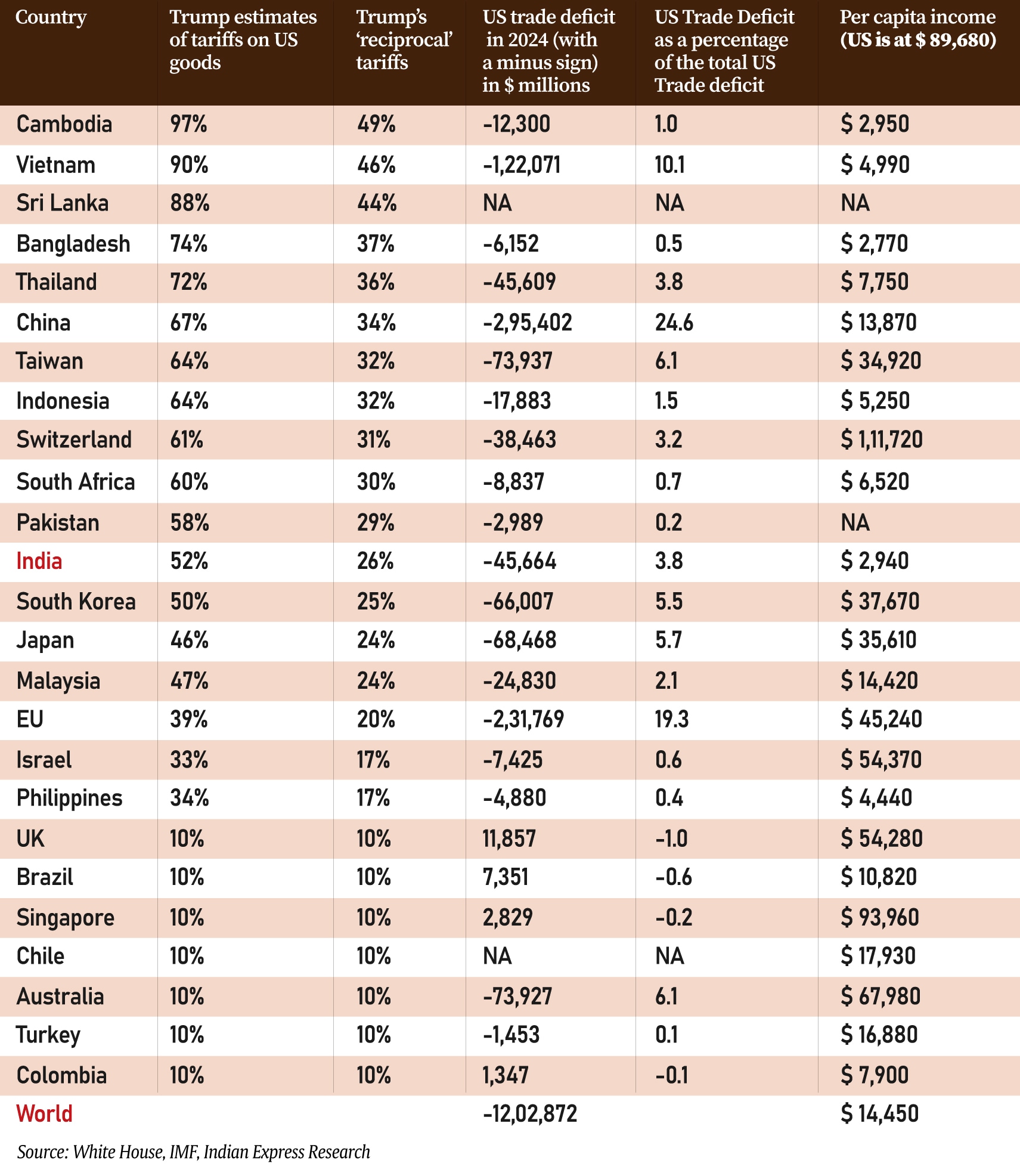 What the tariffs look like
What the tariffs look like
• While speaking to the media, US Treasury Secretary Scott Bessent said that if the tariffed countries “do not panic” then these tariffs will be the cap of how high tariffs can go. In other words, if countries react and retaliate, then the US can further increase the tariffs since it is in any case going by a reciprocal logic.
• Bessent’s comment can also mean that the US is now open to negotiations, and that if the leaders of these countries rush to the US, hat in hand, promising to bring down their own tariffs, then the US may bring down its newly announced tariffs. For instance, in India’s case, to get a reprieve on tariffs, India’s leadership may have to reform its protectionist policies out of compulsion.
Do You Know:
• President Trump has unleashed a wave of protectionism that is worse than the one the US witnessed during the Great Depression of the 1930s.
• The so-called Smoot-Hawley Act had then raised import tariffs in the US in a bid to save the domestic industry and farmers. However, the move worsened and deepened the economic depression.
• An economic depression is worse than a recession both in terms of its severity — the contraction of economic output and rise in unemployment — as well as its scale — often lasting years instead of months.
• Here are the likely consequences of Trump’s tariffs for the US and global economy:
1. Slower growth in the US—Even if no country retaliates, these tariffs will throw heaps of sand in the wheels of global trade, and slow down overall economic growth everywhere. In the next few days, assuming no retaliation happens, stock markets will likely fall to reflect the lower profit outlook of companies and the lower growth prospects in the broader economy. If retaliations take place, then the growth outlook becomes even worse. Expect rating agencies to raise the probability of recession in the US.
2. Higher inflation in the US—There is only one way in which US citizens can escape inflation: if the value of the dollar relative to other currencies goes up by the degree to which the tariffs have been imposed. For instance, relative to India, if the dollar strengthens by 26% in a short period of time — that is, the rupee falls from 85 to a dollar to 108 to a dollar — then the US consumer will not feel the pinch of tariffs.
3. Stagflation and its political fallout—If growth falters and inflation spikes, the US could face the worst of both worlds in the form of “stagflation” — a scenario where growth stagnates and inflation continues to remain high.
4. High inflation, slower growth, elsewhere— The rest of the world too will slow down and face higher prices, depending on countries’ dependence on the US economy and their ability to find newer trading partners and supply chains.
Other Important Articles Covering the same topic:
📍How did the US calculate reciprocal tariffs? Not how Trump said it would
HOW SMOOT-HAWLEY TARIFF ACT DEEPENED THE GREAT DEPRESSION
Syllabus:
Preliminary Examination: Current events of national and international importance.
Main Examination: General Studies I: History of the world will include events from 18th century such as industrial revolution, world wars, redrawal of national boundaries, colonization, decolonization, political philosophies like communism, capitalism, socialism etc.— their forms and effect on the society.
What’s the ongoing story: US President Donald Trump’s tariffs announcements have prompted a comparison with the Great Depression-era Smoot-Hawley Tariff Act, which ended up worsening the crisis it intended to resolve.
Key Points to Ponder:
• What you know about Smoot-Hawley Tariff Act?
• How Smoot-Hawley Tariff Act spurred a trade war?
• What you know about the Great Depression?
• How Smoot-Hawley Tariff Act shaped international economic relations?
• Compare the economic consequences of the Smoot-Hawley Tariff Act with modern-day Donald Trump led reciprocal tariffs.
Key Takeaways:
• Scott Lincicome and Colin Grabow, trade experts at the Cato Institute, a think tank promoting free markets, said in a statement: “With today’s announcement, US tariffs will approach levels not seen since the Smoot-Hawley Tariff Act of 1930, which incited a global trade war and deepened the Great Depression.”
• In 1930, Congress passed a bill sponsored by Senator Reed Smoot of Utah and Rep. Willis Hawley of Oregon to raise import duties on 20,000 goods to protect American farmers and businesses. President Herbert Hoover signed this into law, ignoring a petition signed by over 1,000 economists asking him to veto it.
• Hoover, a Republican, had emerged victorious in 1928, having campaigned on agricultural protectionism. The tariff act was originally mooted to protect the American agricultural lobby, which thrived during World War I on the back of increased foreign demand, but now found itself battling debts and low commodity prices amid a glut of produce.
• The stock market crash of 1929 served as an impetus for a wider range of tariffs. The Act placed aggressive tariffs on roughly 25% of all imported goods to the US.
Do You Know:
• The Act spurred a trade war. Major trading partners, including Canada and Europe, retaliated with boycotts, quotas, and their own tariffs on American goods. American exports to retaliating nations fell by 28-32%. The Act jeopardised recovery efforts of countries trying to emerge from the impacts of WW I and the Great Depression.
• According to the Office of the US Historian, US imports from Europe declined from a 1929 high of $1.3 billion to just $390 million in 1932, while US exports to Europe fell from $2,341 million in 1929 to $784 million in 1932. Overall, world trade declined by 66% between 1929 and 1934.
• In 1934, President Franklin D Roosevelt signed the Reciprocal Trade Agreements Act, which transferred the authority for tariff policy from Congress to the White House. This allowed the President to pursue bilateral trade agreements and quickly repeal the tariffs.
• Economist Douglas Irwin, author of Clashing over Commerce: A History of US Trade Policy (2017), told Bloomberg that Trump’s tariffs would be “much bigger than Smoot-Hawley” due to the scale of today’s trade, with US imports amounting to 14% of its GDP, three times the share in 1930.
Other Important Articles Covering the same topic:
AMONG TARIFFED: ISLANDS WERE ONLY PENGUINS, US MILITARY LIVE
Syllabus:
Preliminary Examination: Current events of national and international importance.
Main Examination: General Studies II: Effect of policies and politics of developed and developing countries on India’s interest
What’s the ongoing story: Donald Trump has imposed a 10% tariff on imports from the Heard and McDonald Islands. Exactly what these imports might be is anyone’s guess.
Key Points to Ponder:
• Map Work-Heard and McDonald Islands, Cocos (Keeling) Islands, Christmas Island, and Norfolk Island.
• No human is believed to have set foot on the Heard and McDonald Islands, so why did Trump impose a 10% tariff on this island?
• What is the significance of Heard and McDonald Islands?
• How such remote territories like Heard and McDonald Islands contribute to global strategic interests?
Key Takeaways:
• Trump has also imposed a 10% tariff on the British Indian Ocean Territory (BIOT), which comprises the Chagos archipelago, a group of low-lying islands in the Indian Ocean, between the Maldives and Mauritius.
• The largest Chagossian island, Diego Garcia, is home to a strategic joint US-UK military base. Home to approximately 4,000 American and British military personnel, it is the only currently inhabited island in the BIOT. Chagos does not have any civilian inhabitants.
Do You Know:
• The volcanic islands are one of seven external territories belonging to Australia, located roughly 4,100 km to the south-west of Perth, and 1,600 km to the north of the Antarctic coast. Covered in glaciers, and barren for the most part, the archipelago is among the most remote places on the planet, home to only penguins, seals, and seabirds
• Donald Trump has imposed a 10% tariff on imports from the Heard and McDonald Islands.
• The Heard and McDonald Islands are not the only baffling entry on Trump’s list of “countries” on which the United States has imposed reciprocal tariffs. In the list are three other Australian external territories: Cocos (Keeling) Islands, Christmas Island, and Norfolk Island.
• Of note here is the case of Norfolk Island, which has been slapped with a 29% tariff — 19 percentage points higher than the rest of Australia. Located roughly 1,600 km to the north-east of Sydney, the island has around 2,000 permanent inhabitants.
Other Important Articles Covering the same topic:
📍ExplainSpeaking: Trump’s reciprocal tariffs — impact on India, rest of the world
| PRELIMS ANSWER KEY |
| 1. (d) 2.(d) 3.(d) |
For any queries and feedback, contact priya.shukla@indianexpress.com
Subscribe to our UPSC newsletter. Stay updated with the latest UPSC articles by joining our Telegram channel – IndianExpress UPSC Hub, and follow us on Instagram and X.
Must Read
Buzzing Now
Apr 06: Latest News
- 01
- 02
- 03
- 04
- 05




